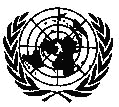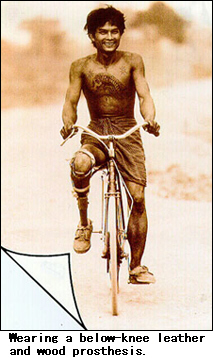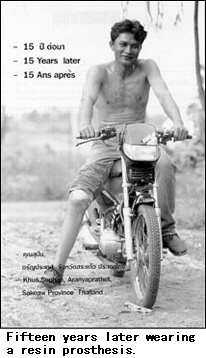ECONOMIC AND SOCIAL COMMISSION FOR ASIA AND THE PACIFIC
PRODUCTION AND DISTRIBUTION OF ASSISTIVE DEVICES FOR PEOPLE WITH DISABILITIES
Part One:
Regional Review

UNITED NATIONS
New York, 1997

ST/ESCAP/1774
UNITED NATIONS PUBLICATION
Sales No. E.98.II.F.7
Copyright c United Nations 1997
ISBN: 92-1-119775-9
The designemployed and the presentation of the material in this publication do not imply the expression of any opinion whatsoever on the part of the Secretariat of the United Nations concerning the legal status of any country, territory, city or area or of its authorities, or concerning the delimitation of its frontiers or boundaries.
Mention of firm names and commercial products does not imply the endorsement of the United Nations.
This publication has been issued without formal editing.
contents


Preface
Full participation and equality is the goal of the Asian and Pacific Decade of Disabled Persons, 1993-2002. Achievement of this goal involves creating an environment that welcomes the inclusion of persons with disabilities in mainstream community life.
With respect to the reduction of the physical barriers to inclusion, there are two essential and complementary means. One is through the creation of barrier-free built environments. The other is through increasing the availability of appropriate assistive devices, with the requisite services for needs assessment, training, follow-up, as well as repair and maintenance.
ESCAP's on-going work on the promotion of non-handicapping environments for persons with disabilities and older persons in the Asia-Pacific region, including accessible public transport systems and services, seeks to enhance the first means. The present publication is the outcome of ESCAP's initial efforts to strengthen the second means.
In the developing countries of the ESCAP region, relatively few people have the use of assistive devices which are essential for freedom of movement and choice in daily life. Those who do are likely to be found in large urban centres, where rehabilitation services are concentrated. Among them are those who can afford to buy the most expensive services and devices available on the market. This publication is not about assistive devices for the privileged few. Instead, the focus is on the needs of the majority who are excluded from services and opportunities.
This publication is part of an ESCAP project entitled "Promotion of regional cooperation for the local production of assistive devices for persons with disabilities". The project grew out of serious concern over the limited availability of culturally-appropriate, high-quality and low-cost assistive devices. At the same time, it was recognized that the potential existed within the region for addressing this concern.
The exchanges and information dissemination under the project are a contribution to technical cooperation, especially among developing countries, to spur greater effort on assistive devices for the poor. This publication is primarily aimed at senior policy makers and programme personnel in diverse mainstream development sectors.
Established channels will direct an ESCAP publication concerning disabled persons to departments for social welfare and community development. The issues raised in this publication, however, require the attention of senior personnel responsible for national development planning, science and technology education, research and development, manufacture of industrial materials, poverty alleviation, rural development, primary health care, skills development, employment promotion, as well as coordination of non-governmental organizations, development aid and technical cooperation.
The publication demystifies the subject so that the above-mentioned senior personnel can use their positions to support improvements in local innovation, production and distribution of assistive devices. They can achieve this through policy decisions and resource allocations. By raising issues concerning the subject of appropriate assistive devices in the forums they participate in, senior personnel can include it in the development agenda. The recommendations and sample national plan in Part I of the publication are a guide to action by this group. In this way, senior policy makers and programme personnel can be part of a wider endeavour to help harness the potential within the ESCAP region, to benefit millions of disabled persons.
The seed for the project was planted by Mr. Rafeeudin Ahmed, who was Executive Secretary of ESCAP from April 1992, when the Commission declared the Decade, until September 1994, when he assumed the position of Associate Administrator of UNDP. Subsequent development and implementation of the project was further inspired by pioneers in the field, both individuals and organizations, whose work is cited in the publication.
The publication is based on a manuscript prepared by Mr. R. Saha, Director, Department of Science and Technology, Government of India, in his capacity as consultant to ESCAP. Among the challenges faced by the Secretariat in undertaking this new work was the difficulty of obtaining comprehensive information. The difficulty was compounded by the fact that, in many cases, current information was not documented at all or was not available in English. Thus, with this publication, it is hoped that many more will be encouraged to join in regional networking, to enrich the indigenous production of assistive devices.
The Government of the Republic of Korea extended generous funding support for the project. That funding support enabled the Secretariat to take the first step towards helping to meet the region's critical need for information dissemination and networking on indigenous assistive devices.
The Government of India contributed additional funding and technical support, particularly through the hosting of the Technical Workshop on the Indigenous Production and Distribution of Assistive Devices, held at Madras (now known as Chennai), India, from 5 to 14 September 1995.
Handicap International's funding support also enhanced participation in the Workshop. For excellent cooperation extended in the finalization of the publication, the Secretariat is grateful to Handicap International (HI) staff at Bangkok (Mr. Yann Drouet and Ms. Maria Carmen-Seage), Phnom Penh (Mr. Marc Bonnet) and Paris (Dr. Philippe Chabasse and Mr. Abdi Bouheddi).
Appreciation is due to all who contributed to the publication; their names are indicated in the relevant sections.
In addition to HI, the Secretariat is grateful to other members of the Subcommittee on Disability-related Concerns of the Regional Interagency Committee for Asia and the Pacific (RICAP), as well as its network partners, who reviewed relevant parts of the manuscript and/or contributed items for inclusion. The following were particularly helpful: Mr. Douglas Krefting of the Centre for Disability in Development (Bangladesh), Ms. Mohua Paul of the Centre for the Rehabilitation of the Paralysed (Bangladesh), Mr. Johann Borg of Inter-Life Bangladesh, Mr. Sun Zhonghua of the China Disabled Persons' Federation, Colonel D.S. Vohra of Nevedac Prosthetic Centre (India), Dr. Nurul Ainy Sidik of the Ministry of Health, Government of Indonesia, Dr. Gerry Heryati of Fatmawati Hospital (Indonesia), Ms. Francesca Ortali, CBR Consultant of the CBR Office, South Sulawesi (Indonesia), Ms. Venus Ilagan of Disabled Peoples' International (DPI)-Philippines, Mr. Lee Sang Yong of the Ministry of Health and Welfare (Republic of Korea), Mr. Cyril Siriwardene of the Sri Lanka Foundation for the Rehabilitation of the Disabled, Colonel Topong Kulkanichit of DPI-Thailand, Ms. Anuradha Mohit of the Asian Blind Union, Mr. William Brohier of Christoffel-Blindenmission, Ms. Tanya Packer of the International Centre for the Advancement of Community Based Rehabilitation (ICACBR), Mr. Tomas Lagerwall of the International Commission on Technology and Accessibility (ICTA) Information Centre/Rehabilitation International, and Dr. Han Tun and Dr. Enrico Pupulin of the World Health Organization (WHO).
Furthermore, the Secretariat would like to acknowledge the valuable contributions of Mr. Antony Samy of WORTH Trust (India), Mr. David Werner of HealthWrights (U.S.A.) and the National Research and Development Centre for Welfare and Health (STAKES), Government of Finland, especially Dr. Vappu Taipale, Ms. Anja Leppo and Mr. Jouko Kokko.
EXECUTIVE SUMMARY
A t its forty-eighth session in 1992, the Economic and Social Commission for Asia and the Pacific (ESCAP) declared the period 1993-2002 as the Asian and Pacific Decade of Disabled Persons, with the goal offull participation and equality of people with disabilities. In the following year, at its forty-ninth session, the Commission adopted the Agenda for Action for the Decade. Assistive devices (items, such as prosthetic limbs and hearing aids, that directly enable people with disabilities to participate in the activities of daily life) constitute an important area of that Agenda. For many people with disabilities in the developing countries of the ESCAP region, assistive devices are a basic need a need as important as adequate shelter.
This publication provides information on the indigenous production and distribution of assistive devices in Asian and Pacific developing countries. It has two major parts:
- 1. A regional review of production and distribution of assistive devices in Asian and Pacific developing countries;
- 2. The proceedings of the Technical Workshop on the Indigenous Production and Distribution of Assistive Devices held inMadras(1), India, in September 1995, including the papers presented;
-
-
The publication also contains three supplements:<
- A directory of assistive-device producers located in Asian and Pacific developing countries;
- A listing of international and national mandates pertaining to assistive devices;
- Technical specifications and information pertaining to some types of assistive devices of particular relevance for small workshops and organizations concerned with community-based rehabilitation.
-
The regional review covers issues under the following headings:
- Measures by which assistive devices enhance inclusion in society, when combined with accessible environments and social attitude changes in the home, work place and wider community;
- The design and production of specific devices and their parts, including choice of proper materials and design styles to ensure that a device is appropriate for its user;
- Strategies for indigenous production, including difficulties faced with regard to import, mass production and quality control of devices and their components;
- Methods of distributing devices, and information about devices, to the poor and to the rural areas where the need for them is most urgent;
- The importance of repairing and maintaining devices, especially in the rural areas;
- Options for training personnel concerned with assistive devices, from skilled rehabilitation technologists to users themselves;
- Approaches to the innovation of new devices, from laboratory research to village-level innovation by users;
- Areas for technical cooperation by which developing countries in the region can help each other improve their services for producing and distributing devices.
A summary of recommendations in the regional review covers action by the following groups: device designers, producers, health-care personnel, distributors and repair personnel, people with disabilities, and rural development organizations and agencies.
The regional review closes with a sample national plan on assistive devices. The plan contains, inter alia, the following recommendations:
-
(a) Members of the United Nations system could, in close collaboration with Governments and NGOs in the Asia-Pacific region, undertake the following:
- Share resources for training and innovation;
- Exchange information on national and local experiences;
- Facilitate exchange of devices within the region;
-
(b) Governments at the central level may take the following actions:
- Coordinate assistive-device services within the country;
- Provide funding support;
- Adopt appropriate regulations and procedures;
- Provide and/or support services for training;
-
(c) Governments at local, municipal, regional, provincial or state levels may take the following actions:
- Collect data on people with disabilities and assistive devices;
- Publicize and distribute information about assistive devices;
- Provide or support services for the production, distribution, repair and maintenance of assistive devices.
- 1. Officially renamed Chennai in 1996.
CONTENTS
- 1. Devices designed suitably for users and their environments
- 2. Inexpensive devices
- 3. Easy-to-use devices
- 1. Poverty and other causes of disabilities
- 2. Levels of need for assistive devices
- 3. Women and girls with disabilities
- 4. Older people and children with disabilities
II. ASSISTIVE DEVICES AND INCLUSION IN SOCIETY
- 1. Agriculture and other rural employment
- 2. Employment in the manufacturing and service sectors
III. DESIGN AND PRODUCTION OF SPECIFIC DEVICES
- Lower-limb prostheses
- Upper-limb prostheses
- Orthoses
- Wheelchairs and ground mobility devices
- Tricycles and adapted motorcycles
- Devices for people with visual impairments
- Devices for people with hearing impairments
IV. DESIGN AND PRODUCTION OF PARTS
-
Prostheses
- # Prosthetic feet
- Orthoses
- Wheelchairs and tricycles
- Devices for people with visual impairments
- Devices for people with hearing impairments
V. ISSUES IN INDIGENOUS PRODUCTION
- User-specific devices
- Appropriate technologies and production methods
- Mass production
- Prescription
- Quality control
- NGO-government cooperation
- Raw materials
- Imports
- Distribution to rural areas
- Options for distribution methods and policy
- Information dissemination
- National policies on distribution
- Recognition of technicians
- Levels of training
- Training of technologists and technicians
- National provisions for training
IX. INNOVATION, RESEARCH AND DEVELOPMENT
- Informal innovation
- Participation of people with disabilities
- Government subsidies and global trade regimes
- Patents and intellectual property
-
Examples of national initiatives
- 1. China: A national R&D centre
- 2. India: A national research project
- 3. Thailand: Application of science and technology
- Device designers
- Producers
- Health-care personnel
- Distributors and repair personnel
- People with disabilities
- Rural development organizations and agencies
- National governments, and regional and international organizations
XII. SAMPLE NATIONAL POLICY AND PLAN
- 1. Share resources for training and innovation
- 2. Exchange information on national and local experiences
- 3. Facilitate exchange of devices within the region
- 1. Coordinate assistive-device services within the country
- 2. Provide funding support
- 3. Adopt appropriate regulations and procedures
- 4. Provide and/or support services for training
- 1. Collect data on people with disabilities and assistive devices
- 2. Publicize and distribute information about assistive devices
- 3. Provide or support services for the production, distribution, repair and maintenance of devices
ANNEX
Annex II: LIST OF ABBREVIATIONS
Annex III: MEMBERS AND ASSOCIATE MEMBERS OF ESCAP
BOXES
I. Box 1: Who Can Use This Publication?
I. Box 2: Examples of Assistive Devices
I. Box 3: Twelve Principles of Assistive-Device Production and Distribution
I. Box 4: Current Definitions: Impairment, Disability and Handicap
II. Box 5: Abdul Matin Mahabub's Story
III. Box 7: Devices for People Affected by Leprosy
III. Box 8: The Wheelchair Maintenance Clinic, Nonthaburi, Thailand
III. Box 9: Wheelchair TCDC Outcome in the Philippines
III. Box 10: Making Use of Low Vision
IV. Box 11: Dr. P.K. Sethi and the Jaipur Designs
IV. Box 12: Parts for Different Lower-Limb Orthoses
V. Box 13: Assessment: Key Questions
V. Box 14: Imports related to Assistive Devices
VII. Box 15: KAMPI's Wheelchair Projects
VIII.Box 16: Curriculum for Prosthetic and Orthotic Technologists
IX. Box 17: Professor Jin Dewen
X. Box 18: TCDC Needs and Interests
Photo Credit
| Credit Due |
| John Ang, Department of Social Work and Psychology, National University of Singapore |
| Association of People with Disability (ADP), Bangalore, India |
| Centre for the Rehabilitation of the Paralysed (CRP), Savar, Bangladesh |
| Handicap International -Thailand |
| KAMPI |
| Topong Kulkhanchit, Association of the Physically Handicapped,Thailand (APHT) |
| Ministry of Welfare, Government of India |
| Rehabilitation Technology Centre, Ministry of Welfare, Government of India |
| R. Saha, Department of Science and Technology. Government of India |
| Antony Samy, WORTH Trust, Katpadi, India |
| San Yuenwah, Social Development Division, ESCAP |
| Cyril Siriwardene, Sri Lanka Foundation for the Rehabilitation of the Disabled |
| D.S. Vohra, Nevedac Prosthetic Centre, Chandigarh, India |
| Wang Tao, China Disabled Persons' Federation (CDPF) |
| David Werner, HealthWrights, Palo Alto, USA |
| Yakkum Rehabilitation Centre, Yogyakarta, Indonesia |
Illustration Credit
| Credit Due |
| Siriwalla Kosin, Population Division, ESCAP |
| National Institute of Design, Ahmedabad, India |
| David Werner, HealthWrights, Palo Alto, USA |
ECONOMIC AND SOCIAL COMMISSION FOR ASIA AND THE PACIFIC
Production and distribution of assistive devices for people with disabilities: Part 1
- Contents -
Printed in Thailand
November 1997 1,000
United Nations Publication
Sales No. E.98.II.F.7
Copyright c United Nations 1997
ISBN: 92-1-119775-9
ST/ESCAP/1774
